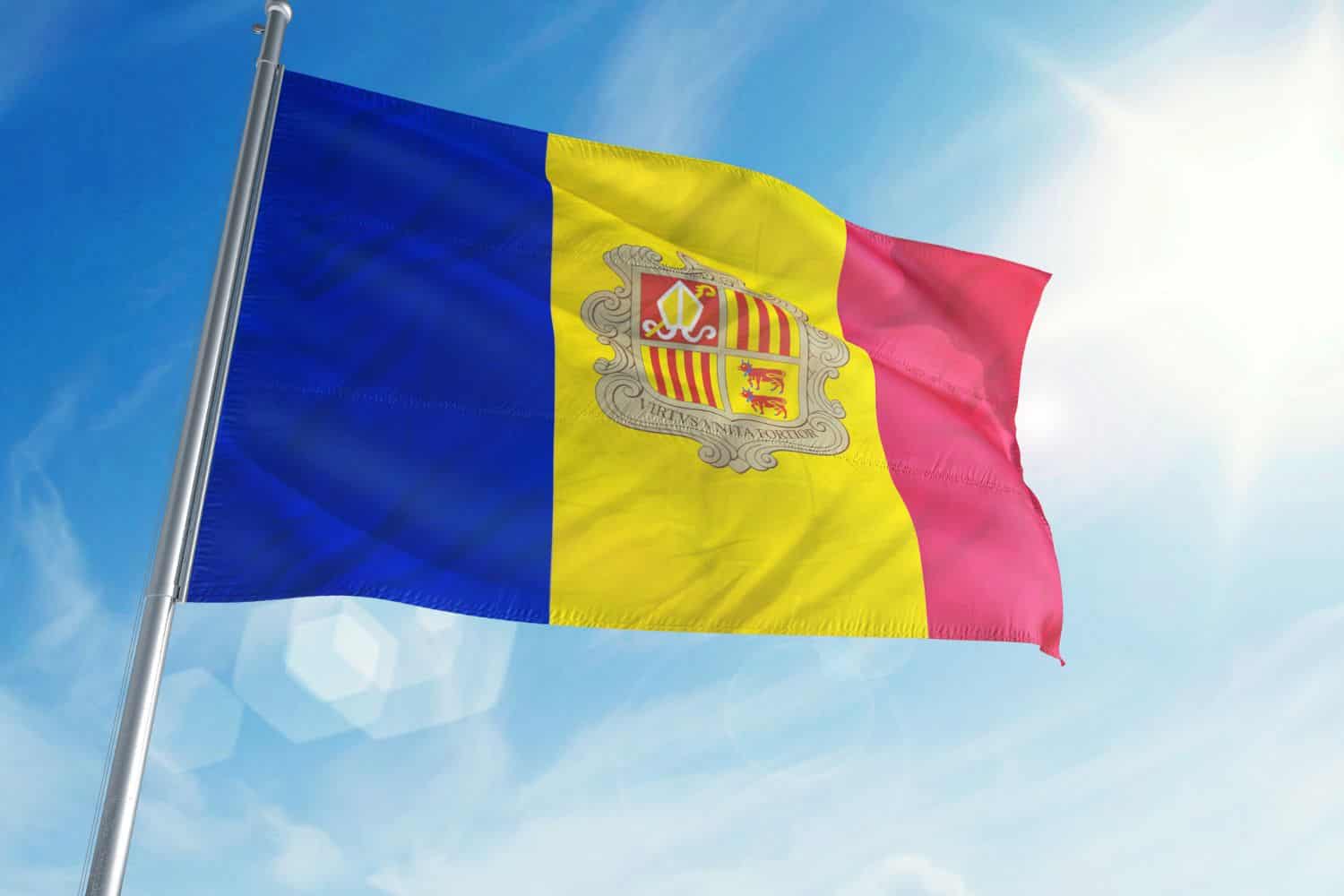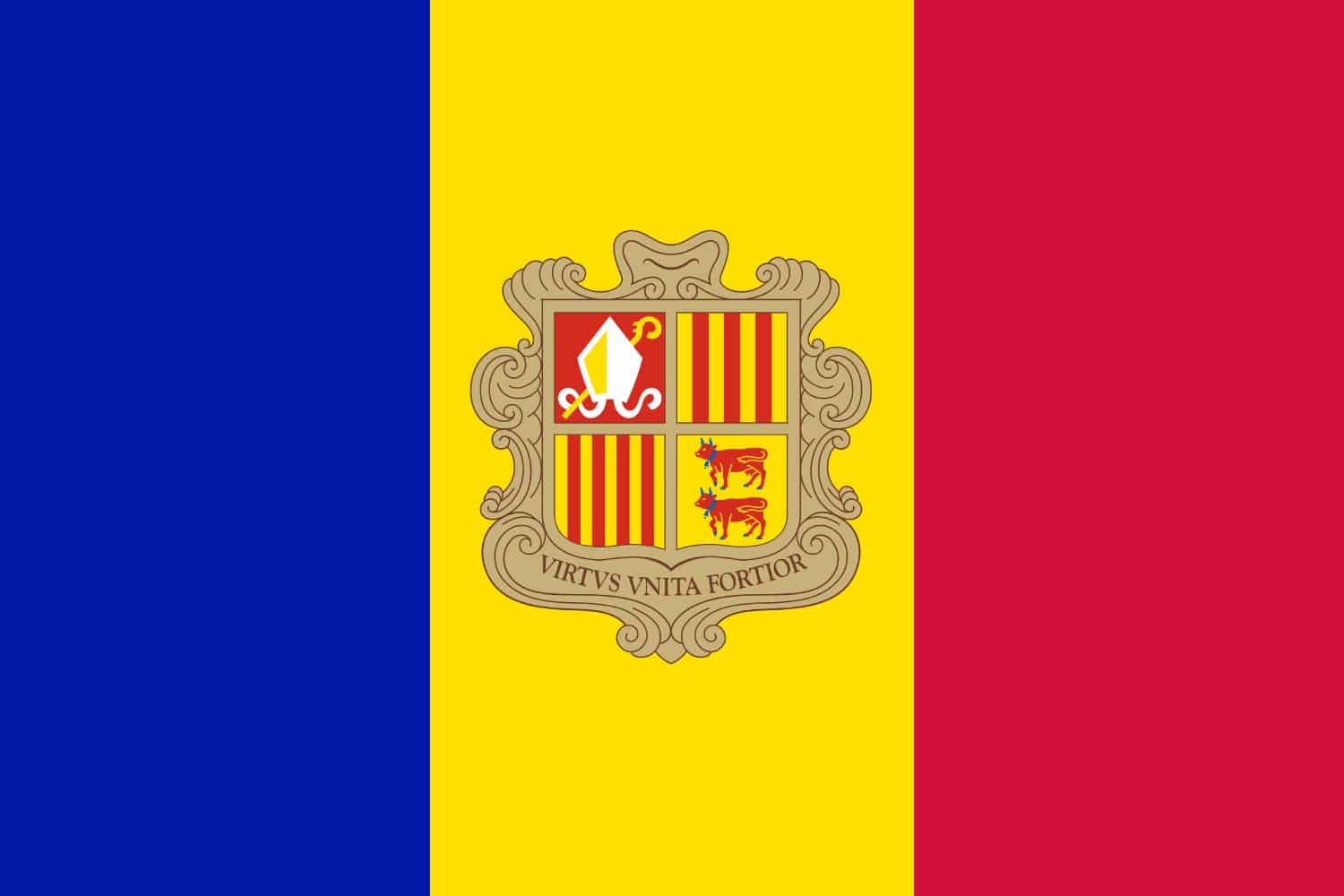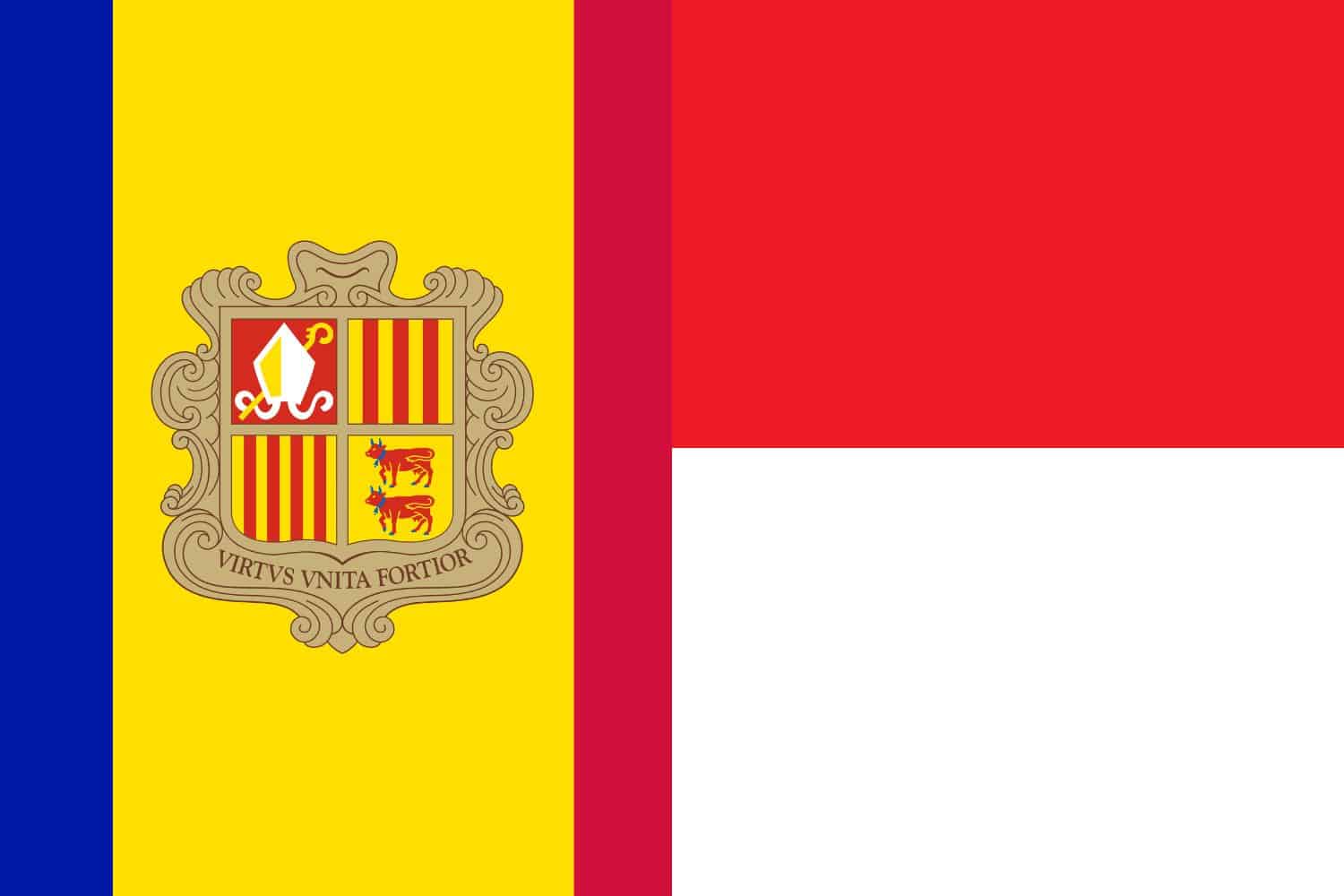Table of Contents
The Andorran flag, known as the flag of Andorra, plays a significant role in the nation’s history and culture, embodying the Andorran identity and heritage. With its unique colors and symbolic significance, the flag stands as a proud emblem of unity and patriotism. In this article, we will uncover the intriguing aspects of the flag, exploring its design, historical background, and the symbolism of its elements.
The Andorran flag comprises three vertical bands of blue, yellow, and red, with the national coat of arms centered on the yellow band. The colors and the coat of arms carry profound meaning for the people of Andorra, representing the nation’s values, aspirations, and historical importance.
Andorra Flag: Colors and Symbolism
- The flag of Andorra features three vertical bands of blue, yellow, and red. In the center of the yellow band is the Andorran coat of arms.
- The blue band symbolizes the commitment to freedom and independence, reflecting Andorra’s values.
- The yellow band embodies peace, while the red signifies bravery and strength. Together, these colors reflect the nation’s proud heritage and identity.
Flag of Andorra

The Andorran flag displays three vertical bands: blue, yellow, and red from left to right. The coat of arms is positioned centrally in the yellow band.
The blue band represents the nation’s commitment to freedom and independence. It embodies Andorra’s unwavering belief in these principles throughout its history.
The yellow band symbolizes peace and hope, reflecting Andorra’s harmonious values and its aspirations for a prosperous future.
The red band signifies the bravery and strength of Andorra’s people. It reminds them of the sacrifices made to protect their independence and identity.
The coat of arms in the center includes the emblems of the four significant historical regions, which together reflect the unity and strength of Andorra. It symbolizes the unique blend of heritage and values that define the nation today.
National Flag Etiquette and Protocol

Respecting the proper usage and display of the Andorran flag is crucial for maintaining national pride and reverence. Understanding flag etiquette is essential, particularly during national events and ceremonies. Learn about the protocols governing the handling, hoisting, and lowering of the flag. Discover the appropriate procedures for retiring or handling damaged flags, ensuring they are accorded the respect they deserve.
- Proper Handling: It is imperative to handle the flag with care and respect. Avoid letting it touch the ground or floor, and hold it upright without dragging.
- Hoisting and Lowering: The flag should be hoisted briskly and lowered ceremoniously. It is customary to hoist the flag at sunrise and lower it at sunset, following specific guidelines or occasions.
- Displaying the Flag: When displaying the flag vertically, the blue band should be on the top, followed by the yellow band in the middle, and the red band at the bottom. Ensure the flag is freely flown and not entangled or obstructed.
- Half-Staff: Lowering the flag to half-staff is a gesture of mourning or respect. This should be done on specific days of remembrance or as directed by authorities to honor national tragedies or the passing of significant figures.
- Flag Retirement: When a flag becomes damaged, torn, or worn out, it should be retired in a dignified manner. Follow appropriate guidelines and local regulations for retiring the flag, which may include burning it in a respectful and solemn ceremony.
- Flag Size and Placement: The size of the flag displayed should be proportionate to the flagpole or display area. Consult local guidelines or authorities for specific rules regarding flag size and placement.
- Respectful Disposal: If a flag cannot be retired through burning, it should be disposed of in a respectful manner. Consider burying it or handing it over to authorized organizations that specialize in flag disposal.
Interesting Facts and Trivia

Embark on a journey of fascinating facts and lesser-known trivia about the Andorran flag. Discover unique features within the flag’s design that hold hidden symbolism. Uncover stories of famous incidents or events involving the flag that have left an indelible mark on the nation’s history and identity.
Rich Tapestry of History
- 1866: The current flag of Andorra was adopted, featuring a vertical tricolor of blue, yellow, and red, with the national coat of arms in the center. This design symbolizes the historical allegiance of Andorra to the Bishop of Urgell and the Count of Foix.
- 1993: Andorra became a member of the United Nations, gaining international recognition while proudly flying its distinctive flag, representing the principality’s sovereignty and unique cultural heritage.
These historical facts highlight significant moments in the history of the Andorran flag, showcasing its role in shaping Andorra’s national identity and symbolizing its rich history and traditions throughout the centuries.
Flag-Related Symbols and Emblems
A flag is not alone in representing a nation’s identity. Explore additional national symbols and emblems closely associated with Andorra, understanding their significance and how they relate to the flag. Delve into their historical and cultural roots, further enriching your understanding of the principality’s heritage. Andorra’s tourist attractions are plentiful and full of interesting historical facts.
Symbolisms of the Andorran Flag
The flag of Andorra holds several symbolic elements that represent the nation’s history, values, and aspirations. Here are the symbolisms of the Andorran flag presented in itemized form:
- Blue Color: Represents the clear skies and rugged mountain landscapes of the Pyrenees, symbolizing freedom, openness, and the natural beauty of Andorra’s environment.
- Yellow Color: Symbolizes the wealth and prosperity of Andorra, reflecting the principality’s economic stability and thriving tourism industry.
- Red Color: Represents the valor, courage, and determination of the Andorran people throughout history, particularly in defending their sovereignty and independence.
- Coat of Arms: The national coat of arms featured in the flag’s center represents the historical allegiance of Andorra to the Bishop of Urgell and the Count of Foix, signifying the principality’s unique political and cultural heritage.
- Historical Legacy: The flag symbolizes Andorra’s rich history, including its traditional governance system, cultural traditions, and strategic location in the Pyrenees mountains.
- National Identity: The flag serves as a unifying symbol for the Andorran people, reminding them of their shared values, traditions, and cultural identity as a sovereign principality.
- National Aspirations: Through its design and elements, the flag embodies the aspirations and values of the Andorran nation, including independence, prosperity, unity, and preservation of cultural heritage.
These symbolisms in the flag contribute to Andorra’s sense of identity and pride, reflecting its historical journey and cultural significance as a sovereign principality nestled in the heart of the Pyrenees mountains.
Flags of Similar Countries or Regions
Examining the flags of neighboring countries or regions can provide intriguing insights. Compare and contrast the flags, exploring similarities in design, colors, or symbolism. Uncover historical and cultural connections between flags, shedding light on shared influences or distinctive identities. Making a tour of Syria is always a possibility in total safety.
Andorran Flag vs Spanish Flag

Similarity: Both flags prominently feature the color red, symbolizing valor and courage.
Difference: The Andorran flag consists of vertical stripes of blue, yellow, and red, with the national coat of arms in the center, while the Spanish flag features horizontal stripes of red and yellow, with the Spanish coat of arms off-centered toward the hoist side.
Andorran Flag vs French Flag

Similarity: Both flags incorporate the colors blue, white, and red.
Difference: The Andorran flag features vertical stripes of blue, yellow, and red, while the French flag has vertical stripes of blue, white, and red in that order from left to right.
Andorran Flag vs Catalan Flag

Similarity: Both flags incorporate the colors blue and yellow.
Difference: The Andorran flag features additional red and white stripes, while the Catalan flag consists of horizontal stripes of red and yellow.
Andorran Flag vs Portuguese Flag

Similarity: Both flags feature the colors red and green.
Difference: The Andorran flag has a yellow stripe, while the Portuguese flag has a coat of arms featuring various elements including a shield with multiple charges and a green field.
Andorran Flag vs Monaco Flag

Similarity: Both flags feature the color red.
Difference: The Andorran flag has a vertical tricolor design with blue, yellow, and red stripes, while the Monaco flag consists of two horizontal bands of red and white.
Andorran Flag vs Swiss Flag

Similarity: Both flags feature the color red.
Difference: The Andorran flag has vertical stripes of blue, yellow, and red, while the Swiss flag is a square with a red background and a white cross in the center.
Frequently Asked Questions (FAQs)
Discover answers to common questions related to the Andorra flag picture. From its historical origins to the symbolism behind its elements, find concise and informative responses that address inquiries commonly posed by those curious about Andorra’s flag.
What do the colors on the flag of Andorra represent?
The colors on the flag of Andorra have specific symbolism. Red symbolizes courage and the defense of freedom, blue represents the sky, yellow signifies the country’s historical allegiance to the Spanish Crown, and green represents the verdant valleys of Andorra.
Why does the Andorran flag have vertical stripes?
The vertical stripes on the flag are a distinctive feature of its design, representing the unique identity and history of the principality. They also differentiate it from neighboring countries’ flags, which often have horizontal stripes.
What is the significance of the coat of arms on the Andorran flag?
The coat of arms featured on the flag represents the historical allegiance of Andorra to the Bishop of Urgell and the Count of Foix, symbolizing the principality’s unique political and cultural heritage.
How long has the current design of the Andorran flag been in use?
The current design of the flag, featuring vertical stripes of blue, yellow, and red with the national coat of arms in the center, has been in use since 1866.
Are there any regulations regarding the display of the Andorran flag?
Yes, there are regulations regarding the proper display of the Andorran flag, particularly during official events and ceremonies. These regulations ensure that the flag is treated with respect and dignity.
What is the historical origin of the Andorran flag?
The historical origin of the Andorran flag dates back centuries and is closely tied to the principality’s unique political history, which includes periods of feudal rule and allegiance to various neighboring powers.
Is there a specific protocol for folding or handling the Andorran flag?
While there may not be a universally standardized protocol for folding or handling the Andorran flag, it is generally recommended to treat the flag with care and respect, avoiding any actions that could damage or disrespect it.
Are there any variations of the Andorran flag used for specific occasions?
There may be variations of the Andorran flag used for specific occasions or events, such as ceremonial flags with gold fringe or flags featuring additional decorative elements for special celebrations.
